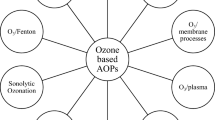Abstract
In the present work, a novel method employing air-bubble cavitation (induced by air bubbles passing small glass balls) combined with nanosized ZnO powder acting as an assistant catalyst, was proposed to degrade some organic dyes in aqueous solution. It was shown that the Acid Red B dye as a model organic pollutant can be decomposed effectively by this method. The degradation process can be described by the pseudo-first-order kinetics and the corresponding rate constants were found to be 0.0041 and 0.0017 min–1 for the process based on air-bubble cavitation combined with nanometer ZnO powder and for the air-bubble cavitation alone, respectively. The influence of operating parameters, such as air-bubbling time, initial concentration, gas flow rate and glass ball size on the degradation of Acid Red B was discussed. The degradation of Acid Red B was monitored by UV–Vis spectroscopy and HPLC. The described method was applied to other similar organic dyes. The experimental results prove that the described method is feasible and promising as an advisable choice for treating non- or low-transparent wastewaters contaminated with various dyes.
Similar content being viewed by others
References
A. M. Talarposhti, T. Donnelly, and G. K. Anderson, Water Res. 35, 425 (2001).
A. Lopez, G. Ricco, R. Ciannarella, A. Rozzi, et al., Water Sci. Technol. 40, 99 (1999).
M. S. Lucas, A. A. Dias, A. Sampaio, et al., Water Res. 41, 1103 (2007).
N. K. Kiliç, J. L. Nielsen, M. Yüce, et al., Chemosphere. 67, 826 (2007).
B. Carlos, J. S. Carla, G. Georg, et al., Ultrason. Sonochem. 14, 355 (2007).
A. Houas, H. Lachheb, M. Ksibi, et al., Appl. Catal. B: Environ. 31, 145 (2001).
M. Saquib and M. Muneer, Desalination 155, 255 (2003).
W. Z. Tang and H. An, Chemosphere 31, 4157 (1995).
V. Meshko, L. Markovska, M. Mincheva, et al., Water Res. 35, 3357 (2001).
W. S. Kuo and P. H. Ho, Chemosphere 45, 77 (2001).
K. S. Suslick, Science 247, 1439 (1990).
Y. T. Didenko, W. B. Mcnamara, and K. S. Suslick, J. Am. Chem. Soc. 121, 5817 (1999).
W. B. Mcnamara, Y. T. Didenko, and K. S. Suslick, Nature 401, 772 (1999).
M. A. Margulis, Ultrasonics 23, 157 (1985).
P. R. Gogate, J. Environ. Manage. 85, 801 (2007).
P. R. Gogate and A. M. Kabadi, Biochem. Eng. J. 44, 60 (2009).
A. G. Chakinala, P. R. Gogate, A. E. Burgess, et al., Ultrason. Sonochem. 15, 49 (2008).
M. N. Patil and A. B. Pandit, Ultrason. Sonochem. 14, 519 (2007).
T. J. Mason and J. P. Lorimer, Applied Sonochemistry (Wiley-VCH, Weinheim, 2003), Vol. 25.
S. Arrojo and Y. Benito, Ultrason. Sonochem. 15, 203 (2008).
A. G. Chakinala, P. R. Gogate, R. Chand, et al., Ultrason. Sonochem. 15, 164 (2008).
R. Xu, R. Z. Jiang, J. Wang, et al., Chem. Eng. J. 164, 23 (2010).
Z. Zhang, Y. Lv, J. Wang, et al., Acta Sci. Circumstant. 29, 955 (2009).
J. Wang, Z. Jiang, L. Zhang, et al., Ultrason. Sonochem. 16, 225 (2009).
J. Wang, Z. Jiang, Z. Zhang, et al., Ultrason. Sonochem. 15, 768 (2008).
S. Sakthivel, B. Neppolian, M. V. Shankar, et al., Sol. Energy Mater. Solar Cells 77, 65 (2003).
N. Guettai and A. Amar, Desalination 185, 427 (2005).
L. H. Thompson and L. K. Doraiswamy, Ind. Eng. Chem. Res. 38, 1215 (1999).
Author information
Authors and Affiliations
Corresponding author
Additional information
The article is published in the original.
Rights and permissions
About this article
Cite this article
Ma, C.H., Zhang, L.Q., Zhang, H.B. et al. Degradation of organic pollutants by air bubbles passing small glass balls in the presence of nanosized ZnO powder. Russ. J. Phys. Chem. 89, 1884–1890 (2015). https://doi.org/10.1134/S0036024415100210
Received:
Published:
Issue Date:
DOI: https://doi.org/10.1134/S0036024415100210




